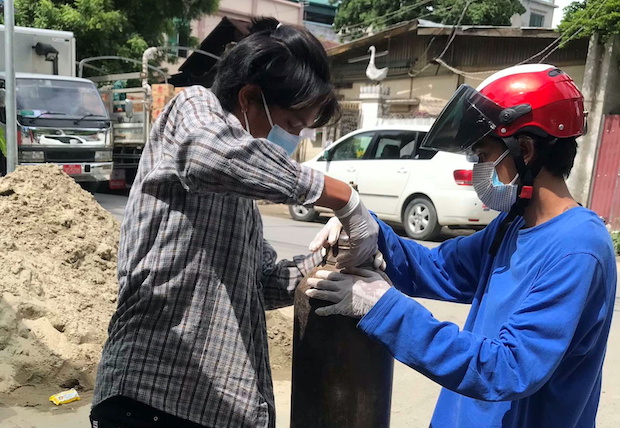COVID-19 response runs underground in junta-ruled Myanmar

A volunteer fills an oxygen tank as coronavirus disease (COVID-19) cases surge in Mandalay, Myanmar July 13, 2021. Picture taken July 13, 2021. (REUTERS)
For a week, 21-year-old student Phoe Thar has been out by dawn to gather oxygen cylinders from the homes of coronavirus sufferers in Myanmar’s second city of Mandalay.
He and fellow volunteers line the tanks up outside charities for filling and returning, trying to save lives in a country whose health system has largely collapsed since a Feb. 1 coup and which now faces its worst surge of COVID-19 infections.
Funded by donors on social media, Phoe Thar and his team are part of a growing grassroots effort that bypasses the authorities and echoes the way Myanmar’s people responded to crises during previous decades of army rule.
“Since the number of people who need oxygen tanks is massive, it’s a huge challenge for us,” Phoe Thar told Reuters by phone from Mandalay.
Health ministry figures showed deaths from COVID-19 reached a record 233 in Myanmar on Saturday, but medics and funeral services say the real toll is much higher, and crematoriums are overloaded.
Article continues after this advertisementThe total official death toll has risen more than 40 percent already this month to 4,769 with the spread of the Delta variant that has also surged elsewhere in Southeast Asia.
Article continues after this advertisementReuters was unable to reach the health ministry or a junta spokesman for comment on the outbreak and public response. A junta spokesman said last week there were difficulties in fighting the outbreak and urged people to cooperate with the government.
The state-run Global New Light of Myanmar newspaper said the health minister, Thet Khaing Win, held a meeting on Saturday “to accelerate the momentum” in tackling COVID-19 – including through an increase in oxygen supplies.
The junta’s critics say lives have been lost because of restrictions it has imposed on some private oxygen suppliers in the name of stopping hoarding.
A health system that was already among the region’s weakest foundered after the coup as many health workers joined a Civil Disobedience Movement to oppose the junta. COVID-19 vaccination, testing, and prevention measures all stalled.

‘The hospitals can’t do anything’
One underground doctor who recently volunteered help on social media said he was inundated with hundreds of requests. When he made house calls he found almost all the sick had coronavirus symptoms and most had low oxygen levels.
“The situation is severe,” said the doctor, who works under the name Pa Gyi. “The hospitals can’t do anything for them… I can’t just sit and watch as the patients are getting helpless.”
He contrasted the situation with that during two previous waves of the coronavirus that were largely brought under control by the government of elected leader Aung San Suu Kyi, who is now deposed and on trial on an array of charges.
Suu Kyi’s government had the advantage of volunteers who manned quarantine and testing centers and helped to take some of the weight at public hospitals.
But far fewer are coming forward to help a military government that still faces daily protests against its seizure of power after alleging fraud in an election landslide by Suu Kyi’s party last year.
Most of the volunteers in Mandalay from the first and second waves of coronavirus infections had disappeared, said Phoe Thar.
Instead, groups like his are organizing by themselves, resembling the way Myanmar’s people often helped each other during disasters in the past – notably after a limited response by a previous junta to the devastating Cyclone Nargis in 2008.
Groups of friends in the main city, Yangon, told Reuters they were clubbing together to try to import oxygen cylinders from neighboring Thailand.
Residents of the town of Kawlin in the western Sagaing Region are trying to raise at least $30,000 to import their own oxygen generator from China.
“Now we are suffering the third wave of COVID. We don’t know how many more waves there we will be,” one of the organizers told Reuters by phone, declining to be named for fear of reprisals. “We now have to act as though we don’t have any government.”